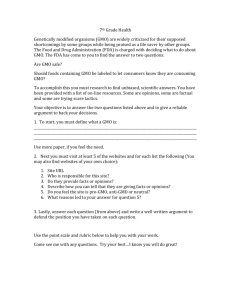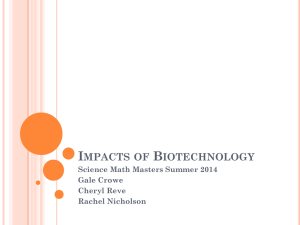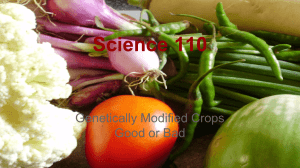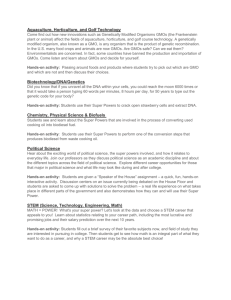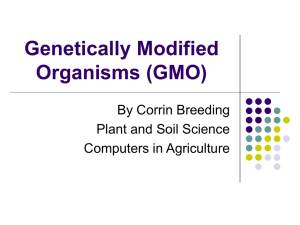Elizabeth Flynn 6 December 2013 EILS Curriculum Proposal
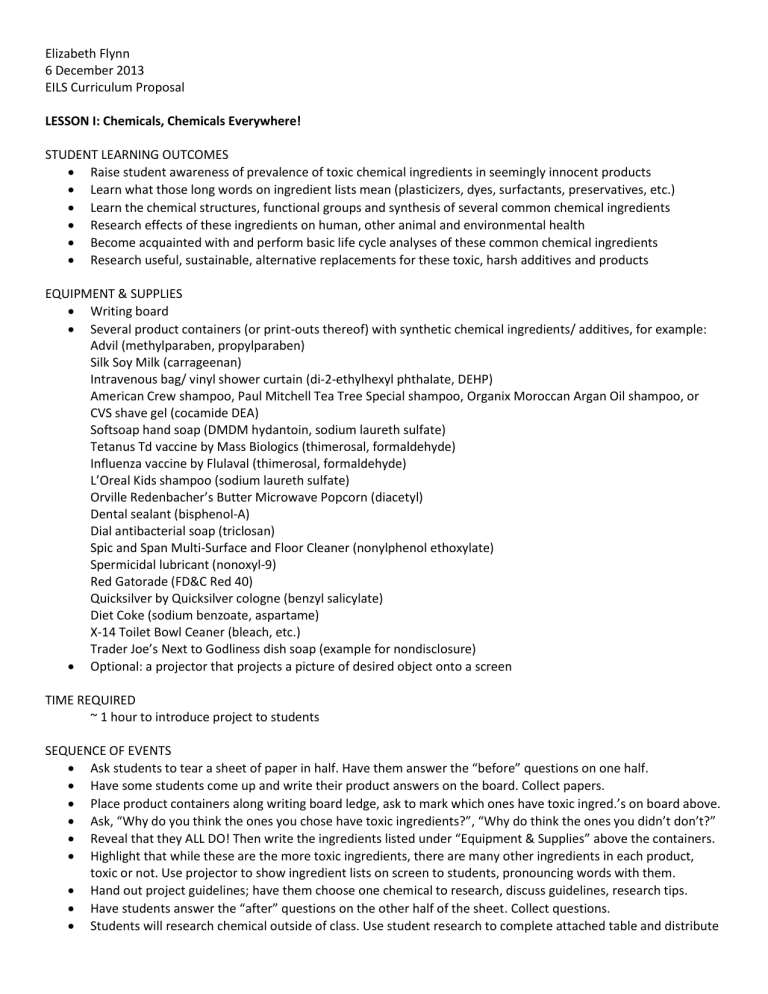
Elizabeth Flynn
6 December 2013
EILS Curriculum Proposal
LESSON I: Chemicals, Chemicals Everywhere!
STUDENT LEARNING OUTCOMES
Raise student awareness of prevalence of toxic chemical ingredients in seemingly innocent products
Learn what those long words on ingredient lists mean (plasticizers, dyes, surfactants, preservatives, etc.)
Learn the chemical structures, functional groups and synthesis of several common chemical ingredients
Research effects of these ingredients on human, other animal and environmental health
Become acquainted with and perform basic life cycle analyses of these common chemical ingredients
Research useful, sustainable, alternative replacements for these toxic, harsh additives and products
EQUIPMENT & SUPPLIES
Writing board
Several product containers (or print-outs thereof) with synthetic chemical ingredients/ additives, for example:
Advil (methylparaben, propylparaben)
Silk Soy Milk (carrageenan)
Intravenous bag/ vinyl shower curtain (di-2-ethylhexyl phthalate, DEHP)
American Crew shampoo, Paul Mitchell Tea Tree Special shampoo, Organix Moroccan Argan Oil shampoo, or
CVS shave gel (cocamide DEA)
Softsoap hand soap (DMDM hydantoin, sodium laureth sulfate)
Tetanus Td vaccine by Mass Biologics (thimerosal, formaldehyde)
Influenza vaccine by Flulaval (thimerosal, formaldehyde)
L’Oreal Kids shampoo (sodium laureth sulfate)
Orville Redenbacher’s Butter Microwave Popcorn (diacetyl)
Dental sealant (bisphenol-A)
Dial antibacterial soap (triclosan)
Spic and Span Multi-Surface and Floor Cleaner (nonylphenol ethoxylate)
Spermicidal lubricant (nonoxyl-9)
Red Gatorade (FD&C Red 40)
Quicksilver by Quicksilver cologne (benzyl salicylate)
Diet Coke (sodium benzoate, aspartame)
X-14 Toilet Bowl Ceaner (bleach, etc.)
Trader Joe’s Next to Godliness dish soap (example for nondisclosure)
Optional: a projector that projects a picture of desired object onto a screen
TIME REQUIRED
~ 1 hour to introduce project to students
SEQUENCE OF EVENTS
Ask students to tear a sheet of paper in half. Have them answer the “before” questions on one half.
Have some students come up and write their product answers on the board. Collect papers.
Place product containers along writing board ledge, ask to mark which ones have toxic ingred.’s on board above.
Ask, “Why do you think the ones you chose have toxic ingredients?”, “Why do think the ones you didn’t don’t?”
Reveal that they ALL DO! Then write the ingredients listed under “Equipment & Supplies” above the containers.
Highlight that while these are the more toxic ingredients, there are many other ingredients in each product, toxic or not. Use projector to show ingredient lists on screen to students, pronouncing words with them.
Hand out project guidelines; have them choose one chemical to research, discuss guidelines, research tips.
Have students answer the “after” questions on the other half of the sheet. Collect questions.
Students will research chemical outside of class. Use student research to complete attached table and distribute
during next meeting. I’ll be having them study the table and learn about all the chemicals for the next exam.
Talk with students about sustainability regarding synthetic chemicals. Discuss sustainable options for:
-preservatives (citric acid, vitamins C & E)
-surfactants (lye + triglycerides = soap!)
-dyes (beet, annatto, chlorophyll, mushrooms)
-flavors (natural flavors, but beware! “Natural” flavors can mean many things. Real food shouldn’t need
anything more than herbs and spices!)
-plastics (use biodegradable, nontoxic, plant-based polymers)
-sugar substitute (stevia!)
-antimicrobial/ antiseptic (soap! Thyme, clove, tea tree, lemon, lavender oils! Also vinegar!)
-thickeners (guar gum, arrowroot, agar agar)
-fragrances (holistic essential oils create exquisite, intoxicating aromas for men and women)
Discuss ways to avoid toxic chemicals products:
-Read all labels and avoid chemicals you know are dangerous.
-If you don’t know what an ingredient is, look it up! Make informed decisions.
-If possible, shop at natural foods stores for food and cosmetics. But still read labels! Even “natural”
products can contain nasty stuff.
-Above all else, MAKE YOUR OWN! (I can provide great recipes for lotion, soap and lip balm if desired I will
be bringing samples of these to show students.)
*Some brief notes on chemicals. It should be up to the instructor to research each chemical before the lesson:
propylparaben: paraben preservative for cosmetics, pharmaceuticals, food; endocrine disruptor.
carrageenan: sulfated polysaccharide thickener for foods, cosmetics, toothpaste; intestinal damage, possible tumor promotion
DEHP: phthalate plasticizer; strong endocrine disruptor, feminizing teratogen, possible carcinogen
cocamide DEA: coconut oil-derived foaming agent and thickener; CA Prop 65 human carcinogen, skin irritation
DMDM hydantoin: antimicrobial formaldehyde releasinging preservative; formaldehyde is a known carcinogen
sodium laureth sulfate: anionic surfactant; skin irritation, often contaminated with 1,4-dioxane
thimerosal: preservative used in vaccines and eye-area cosmetics; forms ethylmercury in body, which targets
CNS and kidney, crosses BBB, may correlate with autism
nonylphenol ethoxylate: anionic surfactant in commercial detergents, cleaning products; endocrine disruptors
formaldehyde: preservative, disinfectant, industrial uses; known human carcinogen
diacetyl: artificial butter flavor; lung disease, alzheimer’s link?
bisphenol-A: polycarbonate resin monomer, plasticizer antioxidant, etc., etc.; endocrine disruptor
triclosan: antiseptic; allergies, toxic by-products, carcinogenic metabolites, animal endocrine disruption
nonoxyl-9: surfactant, spermacide; teratogen, endocrine disruptor
FD&C Red 40: dye; hyperactivity, allergies
benzyl salicylate: fragrance; endocrine disruptor
sodium benzoate: preservative; forms benzene when with vit. C, carcinogen
aspartame: sugar substitute; cancer in rats, actually increases diabetic response.
This is a running list. Feel free to add any other chemicals. I will be doing so as I learn more.
ASSESSMENT enrollment cap = 25 students
“Before” Questions:
1.
List at least 5 products you use that contain chemicals.
2.
List at least 5 products you use that contain toxic chemicals.
“After” Questions:
1.
List at least 5 products you use frequently that may contain toxic chemicals.
2.
Which product(s) were you most surprised to learn contain toxic chemicals?
Possible exam question:
Given this ingredient label of a common (product) , identify the categories to which (#) of the chemicals belong. List one major health concern and one major environmental concern associated with each chemical. Give one example of a sustainable replacement for each chemical.
Chemicals, Chemicals Everywhere!
Chem 30B, Spring 2014
Name:
**Cite all sources!! Answer all questions using the backs of unwanted papers already printed or written on!
1.
a) Choose a chemical from the board and write name here: b) Define any acronyms and provide IUPAC name.
2.
Draw its chemical structure and identify all the functional groups you can.
.
3.
Where and how is your chemical extracted or produced? Show all synthetic reactions involved.
4.
a) What is your chemical used for? b) What category does it belong to: dye, fragrance, preservative, plasticizer, antimicrobial, antiseptic, surfactant, sugar substitute, foaming agent, flavoring, or thickener? (>1 possible) c) Give the chemical class, if any, to which your chemical belongs. E.g., saccharin is a non-saccharide sweetener. d) Name at least 2 other chemicals that are in the same category and chemical class.
5.
What commercial products contain your chemical? Include products that list your chemical as an ingredient and those that don’t. List as many as you can. Include specific brands when possible. This may require some digging!
6.
What are the health risks associated with your chemical? Be specific and thorough! Include any by-products or contaminants associated with your chemical. Use ≥ 1 literature source:
Author 1 (Last, F.M.); Author 2; etc.; Title of Article. Journal Abbreviation Year, Volume, pages.
7.
Where does your chemical end up after its intended use? Is it broken down? If so, how? Is it persistent/ does it accumulate?
8.
How does it impact the environment where it ends up and the surrounding life? Include ≥ 1 literature source.
9.
Would you describe your chemical as “sustainable”? Why or why not?
10.
a) Provide at least one sustainable replacement for your chemical. b) In what ways is this replacement sustainable? Briefly how it’s obtained, effects on health, & disposal effects.
11.
Name at least three ways you and the people you care about can work to avoid your chemical and its products.
Chemical Name/
IUPAC/category(ies) propylparaben
Structure/ Functional
Groups
Products Containing
Chemical
Associated Health Risks Environmental Fate Sustainable
Replacements carrageenan
DEHP cocamide DEA
DMDM hydantoin sodium laureth sulfate thimerosal formaldehyde diacetyl
bisphenol-A triclosan nonylphenol ethoxylate nonoxyl-9
FD&C Red 40 benzyl salicylate sodium benzoate aspartame
Any additional chemicals welcome!
LESSON II: OMG, GMO? WTH Is In Your Food?
STUDENT LEARNING OUTCOMES
Become familiar with the prevalence of Genetically Modified Organisms & Crops (GMO & GMC)
Study biochemistry of genetic modification techniques
Learn most common reasons for producing GM crops, i.e. their benefits
Study effects of GMOs on human and other animal health
Study effects of GMOs on crop health and biodiversity
Formulate correlations between GMCs and sustainability
Illustrate the impact of conflicting interests on scientific credibility
EQUIPMENT & SUPPLIES
Serralini, et al. 2012 papers to view and discuss with class up on projector :
Séralini , G.E., et al. Long term toxicity of a Roundup herbicide and a Roundup-tolerant genetically modified maize. Food and Chemical Toxicology 2012, 50, 4221-4231.
** Found here:
Seralini 2012 Long
Term tox of Roundup and Roundup tolerant GM Maize.pdf
RETRACTED version of above paper found here:
RETRACTED
SERALINI PAPER!!.pdf
European Food Safety Authority press release re Seralini paper found here: http://www.efsa.europa.eu/en/press/news/121128.htm
William Engdahl’s article describing Monsanto’s conflict of interest with Seralini paper and journal fraud: http://rt.com/op-edge/monsanto-gmo-studies-reports-588/
Computer and projector
Kashi’s Autumn Wheat Cereal box (has interesting blurb about intentions to use non-GMO wheat without
“sacrificing” quality. As if it would sacrifice the quality!)
Conventional corn products, wheat cereal, potatoes, soy products, etc. to bring in as tactile visuals.
TIME REQUIRED
~One class period
Enrollment cap = 25 students
SEQUENCE OF EVENTS
Start by asking students, “Who has heard of GMOs?” & “Who has eaten any GMOs recently?”
“What does GMO stand for?” (Write answers on board.)
Ask, “What is a GMO?” Students brainstorm, write suggestions on board. If nobody comes up with an acceptable answer, lead them in the direction of something like “an organism whose DNA has literally been changed in order to express or alter a certain trait.”
Ask, “Which crops are most commonly genetically modified?” Corn, soybeans, potatoes, wheat, etc.
Then ask again, “Who has eaten any GMOs recently?” Maybe the number of hands will increase!
Bring up the topics of biodiversity and sustainability as they pertain to GMOs. Ask students to keep these topics in mind during the whole study of GMOs.
Lead students through presentation/discussion about uses for genetic modification:
Am J Clin Nutr-1996
GM of plants, significant issues and hurdles to success.pdf
Describe the first successful transgenic example and how it was done in detail (using above paper)
Describe another way to make GMOs using the example of Roundup (Glyphosate)-Resistant crops and Figure 1
US Patent 4940835
Glyphosate-Resistant Plants.pdf
from US Patent 4940835:
Introduce safety of GMOs and the fact that not many long-term conclusive studies have been performed. Point out to students that many of the studies that declare GMO safety are only short-term and/or performed by the companies that make and market GMOs.
Use the following GMO safety reviews if desired:
Domingo, 2000, Domingo, 2007, Crit Domingo, 2011, Env
Int, Lit review on the safety assessment of GM plants.pdf
Put the original Séralini 2012 paper up on the projector and go though the study and summarize with students.
Show them the Engdahl article and summarize. Ask what they think about the scandal.
Show them the RETRACTED Séralini paper, and ask what they think about it.
This will provide students with a little insight into the political goings-on surrounding GMOs.
Tell students it’s up to them to form an opinion on whether GMOs are beneficial or detrimental.
Introduce project guidelines and remind students how to perform quality research.
ASSESSMENT
Use questions posed during sequence of events.
Extent and understanding of research done for answering project guideline questions.
OPTIONAL REFERENCES FOR INSTRUCTOR OR STUDENT RESEARCH (above icon refs included, in case links don’t work)
*Original Séralini paper: http://research.sustainablefoodtrust.org/wp-content/uploads/2012/09/Final-Paper.pdf
*Retracted Séralini paper: http://www.sciencedirect.com.oca.ucsc.edu/science?_ob=ArticleListURL&_method=list&_ArticleListID=-
467478688&_sort=r&_st=13&view=c&_acct=C000059601&_version=1&_urlVersion=0&_userid=4428&md5=5a2d0c018 dc9d0530a7da71541da94d9&searchtype=a
*See also websites given in EQUIPMENT & MATERIALS
*Day, P.R., Genetic modification of plants: significant issues and hurdles to success, Am J Clin Nutr 1996,63,65lS-6S.
*US Patent on Roundup-Resistant Crops: http://www.google.com/patents?hl=en&lr=&vid=USPAT4940835&id=tDApAAAAEBAJ&oi=fnd&dq=roundup+resistant+cr ops&printsec=abstract#v=onepage&q=roundup%20resistant%20crops&f=false
*Domingo, J.L.,Health Risks of GM Foods: Many Opinions but Few Data, Science,2000,288,1748-1749.
*Domingo, J.L., Toxicity Studies of Genetically Modified Plants: A Review of the Published Literature, Critical Reviews in
Food Science and Nutrition, 2007,47,721-733. DOI: 10.1080/10408390601177670
*Domingo, J.L., A literature review on the safety assessment of genetically modified plants, Environment International,
2011,37,734–742.
*Dona, A. & Arvanitoyannis, I.S., Health Risks of Genetically Modified Foods, Critical Reviews in Food Science and
Nutrition,2009,49,164-175. DOI: 10.1080/10408390701855993
*Funke, T., et al., Molecular basis for the herbicide resistance of Roundup Ready crops, PNAS, 2006, 103, 13010-13015.
*Lichtenstein, A.H., et al., Novel soybean oils with different fatty acid profiles alter cardiovascular disease risk factors in moderately hyperlipidemic subjects, Am J Clin Nutr, 2006,84,497–504.
*Rickard, C., Letter to the Editor Response to “Health Risks of Genetically Modified Foods”, Critical Reviews in Food
Science and Nutrition, 2009,50,85-91.
*Schubert, D.R., The Problem with Nutritionally Enhanced Plants, J Med Food, 2008,11,601–605.
*Wolfenbarger, L.L., Phifer, P.R., The Ecological Risks and Benefits of Genetically Engineered
Plants,Science,2000,290,2088-2093.
Genetic Modification Project Guidelines
Chem 30B, Spring 2014
Name:
Thoroughly answer all questions, using correct punctuation, grammar and syntax. Include at least 5 cited sources. One must be from a peer-reviewed, scientific journal (abstracts OK). Online news articles OK. Wikipedia OK to an extent; research their cited sources to increase credibility!
1.
Choose a genetically modified organism from the following list: rapeseed, corn, Hawaiian papaya, salmon, potato, rice, wheat, soy, cotton.
2.
What characteristic(s) has genetic modification introduced into your GMO?
.
3.
For each characteristic, describe in detail the method(s) used to modify the DNA of your GMO. Pretend you’re talking to a biochemist!
4.
Is your GMO currently on the market? If so, where? Who/ what eats or uses it? Which company owns and markets it? Where is it grown and cultivated? What percentage of the total conventional crop is your GMO responsible for?
5.
If it’s not on the market, what’s the story? Will it be marketed in the? By whom? Has it been taken off the market? Why? If it was once in production, where was it produced/ consumed?
6.
Report at least 3 potential health effects attributed to any aspect of your GMO.
7.
List any potential environmental concerns pertaining to any aspect of your GMO.
8.
What are some potential benefits of GMO production and cultivation?
9.
Describe any other cultural or political issues or controversies you have uncovered.
10.
What problems do you foresee GMOs generating in regard to biodiversity? List at least two.
11.
Are GMOs sustainable? Why or why not?
12.
Do you think GMOs and their products should be labeled? Why or why not?
